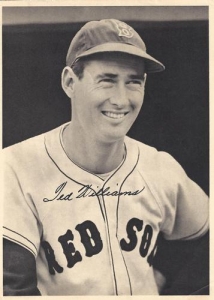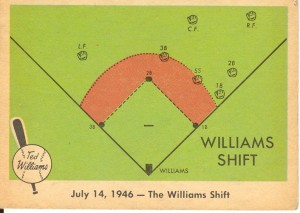July 14, 1946: Lou Boudreau debuts his shift against Red Sox slugger Ted Williams
 As the Cleveland Indians shortstop, Lou Boudreau had seen firsthand the damage Ted Williams could do at the plate. And as the team’s manager, he was determined to do something about it.
As the Cleveland Indians shortstop, Lou Boudreau had seen firsthand the damage Ted Williams could do at the plate. And as the team’s manager, he was determined to do something about it.
Williams had hit three home runs and a single, driving in eight runs, in the first game of the Sunday doubleheader against the Indians at Fenway Park, and for the second game, Boudreau had a trick up his sleeve.
“I had thought about it for weeks,” Boudreau said in 1970 as his induction into the Hall of Fame loomed. “Right then and there, between games of the doubleheader, I decided to use the shift.”1
The idea of a shift—stacking one side of the field against a hitter—wasn’t a new one. Cy Williams of the Phillies had been the victim of a shift in the 1920s. White Sox manager Jimmy Dykes had already used one against Ted Williams, a noted pull hitter to right field.
But Boudreau said it wasn’t a tactical ploy; it was a psychological one. “My plan was predicated on the belief that Williams, who made no secret of the fact that he wanted to be known as the greatest hitter of all time—which I think he was—would be too proud to adjust his style to counteract my strategy, that it would be beneath his dignity to change,” Boudreau said in his autobiography.
With Indians players in their typical positions, Williams doubled in his first at-bat of the game, leading off the bottom of the second and starting a rally that included two doubles, two singles and a fly ball to give the Red Sox a 3-0 lead. The Indians cut the gap to 3-1 in the top of the third, when Hank Edwards singled to score Jack Conway.
Williams came to the plate for the second time in the game with two outs in the bottom of the third. Boudreau yelled, “Yo!” and players changed positions. First baseman Jimmy Wasdell and right fielder Edwards were almost to the foul line. Conway, at second base, moved toward first, in the outfield grass. Third baseman Ken Keltner was behind second base, also on the grass. Center fielder Pat Seerey was playing where a right fielder might normally play, and Boudreau was just to the right of second base.
The only Indians player on the left side of the field was left fielder George Case, playing what Boudreau termed “deep shortstop.”
Williams stepped out of the batter’s box and asked umpire Bill Summers if the move was legal. Summers told him that as long as they were all in fair territory, it was. Williams then grounded to Boudreau, who threw him out at first.
Williams came up to bat again in the sixth, with the Red Sox still leading by two. Again, Boudreau yelled “Yo!” and again, the players shifted. Williams showed bunt—which is exactly what Boudreau’s players said he might do when Boudreau diagrammed the shift in the locker room between games. But even that would be fine by him. “If he wants to cross us up and bunt or hit to left, that will be all right with me,” Boudreau said. “Any time that guy settles for two bases, he’s doing you a favor.”2
Instead, Williams was walked by pitcher Red Embree—who then walked the next batter, Bobby Doerr. Rudy York singled to score Williams, and Rip Russell grounded into a double play, scoring Doerr. Boston led, 5-1.
In the top of the seventh, Embree was lifted for pinch-hitter Gene Woodling, who struck out. Case hit a solo home run to cut the deficit to 5-2, but Conway walked and Seerey grounded into an inning-ending double play.
Bob Lemon came on in relief of Embree in the bottom of the seventh and walked Bill Zuber. Pinch-hitter Tom McBride bunted to advance Zuber to second, and Johnny Pesky singled to send him to third. Dom DiMaggio singled, scoring Zuber, to restore Boston’s advantage to 6-2. Pesky was picked off at second during Williams’s at-bat—with no shift on—and Williams walked before Doerr grounded out to end the inning.
The Indians were able to push two more runs across. Tom Jordan’s single scored Edwards in the eighth, and Boudreau singled in the top of the ninth to score Case, but the Red Sox were able to hold on for the win.
The Indians left town losers of two of three. The Red Sox were 11 games up in the American League, prompting the Cleveland Plain Dealer’s James E. Doyle to write that the pennant race was “all over but the shouting—and clouting.”3
Williams commented, “If everybody starts playing me like that, I guess I’ll have to turn around and hit ’em righthanded.”4 In later years Williams said he didn’t see the shift as doing much damage, that he hit .400 with nine home runs against the Indians that year.5
The Red Sox indeed won the pennant, and their opponent in the World Series—the only fall classic Williams would play in—would be the Cardinals, who also employed an infield shift when Williams batted.6
Teams continued to use a shift against Williams for the next several years. As the manager of the Kansas City Athletics, Boudreau used it a decade later against another slugger, Mickey Mantle.
In 1948 the Indians won the pennant, thanks to a one-game playoff victory over the Red Sox, before beating the Boston Braves in the World Series. Boston sportswriter Harold Kaese said the Indians won the pennant the day in 1946 they first put the shift on, getting into Williams’s head.7
John Updike, the author of a classic essay about Williams’s last game, estimated that the shift took 15 points off his lifetime batting average.8
Sources
Lou Boudreau, with Russell Schneider, Covering All the Bases (Champaign, Illinois: Sagamore Publishing, 1993)
https://www.baseball-reference.com/boxes/BOS/BOS194607142.shtml
https://www.retrosheet.org/boxesetc/1946/B07142BOS1946.htm
Notes
1 Associated Press, “Lou, Ted Williams Still Remember That Shift,” Florence (Alabama) Times—Tri-City Daily, July 28, 1970: 11. https://news.google.com/newspapers?nid=1842&dat=19700728&id=liIsAAAAIBAJ&sjid=zMcEAAAAIBAJ&pg=975,4420920.
2 Ed McAuley, “Williams Hasn’t Faced Too Many Good Pitchers,” Cleveland News, July 15, 1946: 8.
3 James E. Doyle, “The Sports Trail,” Cleveland Plain Dealer, July 15, 1946: 11.
4 “Boudreau Uses ‘Williams Shift,’” Cleveland Plain Dealer, July 15, 1946: 11.
5 Ted Williams with John Underwood, My Turn at Bat, updated edition (New York: Simon & Schuster, 1988), 107. Actually Williams batted .385 and hit 11 home runs against the Indians in 1946.
6 Williams batted .200 against the Cardinals in the World Series.
7 Ben Bradlee Jr., The Kid: The Immortal Life of Ted Williams (New York: Hachette, 2013). https://www.google.com/books/edition/The_Kid/B0R6SzX0JM0C?hl=en&gbpv=1&bsq=lou%20boudreau%20shift
8 John Updike, “Hub Fans Bid Kid Adieu,” The New Yorker, October 22, 1960.
Additional Stats
Boston Red Sox 6
Cleveland Indians 4
Game 2, DH
Fenway Park
Boston, MA
Box Score + PBP:
Corrections? Additions?
If you can help us improve this game story, contact us.


